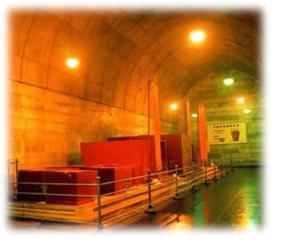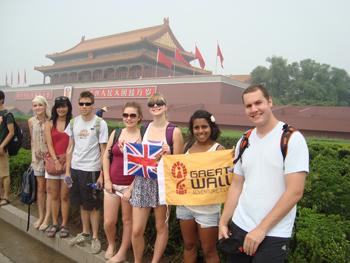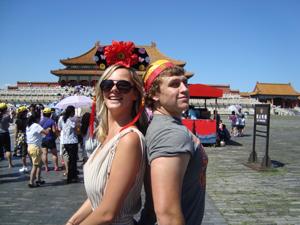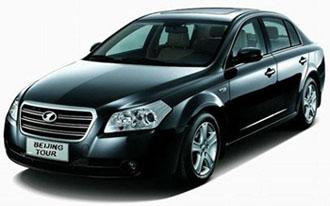[TJPORT 13]
Looking for a reliable and comfortable private
transfer from Beijing to Tianjin Port Xingang with a two-day excursion
in the city? Great Wall Adventure Club is here to help. We have a large
fleet of cars and vans with licensed tour guides and professional
drivers. We make sure that your private transfer will be safe,
comfortable and relaxing.
Day 01: Arrival in Beijing
Upon arrival in Beijing, (at either the train
station or airport), you will be met by your English-speaking guide and
driver. You will be taken to your hotel in Beijing, where you will have
the opportunity to relax and prepare for the days ahead.
Day02: Beijing (L)

You will be picked up from your Beijing hotel at
about 8:30am, and from there we�ll make our way to the Great Wall at
Mutianyu. Although it has gotten a face-lift, it avoids the army of
tourists that plague Badaling. Mutianyu offers some breathtaking views
of the valley and wall below, and if you look to your right you�ll see a
large sign engraved in the side of the mountain encouraging you to
�Cherish the teachings of Chairman Mao�. Mutianyu has also become
popular for visiting foreign leaders and celebrities (former U.S.
President Clinton visited Mutianyu on one of his trips to China).
You can hike down to the parking lot, take a cable
car, or take a toboggan ride (highly recommended, and lots of fun!) down
to meet our driver.
After lunch we�ll make the drive to the Ming Tombs.
The Ming Tombs, about 50 km/31 miles from Beijing, are where 13
emperors of the Ming Dynasty (1368-1644) are buried. This site was
carefully chosen for its feng shui principles by the third Ming emperor
Yongle (who also moved the capital from Nanjing to Beijing and began
construction on the Forbidden City). The tomb we will visit, Dingling,
is the tomb of the Wanli Emperor. It is the only one of the Ming Dynasty
Tombs to have been excavated. It also remains the only imperial tomb to
have been excavated since the founding of the People's Republic of
China. After viewing the tombs, we will head to the �Shenlu�, or the
Spirit Way. The Spirit Way leads into the complex, lined with statues of
guardian animals
 and officials, with a front gate consisting of
three-arches, painted red, and called the "Great Red Gate". The Spirit
Way, or Sacred Way, starts with a huge stone memorial archway lying at
the front of the area. Constructed in 1540, during the Ming Dynasty,
this archway is one of the biggest stone archways in China today.
and officials, with a front gate consisting of
three-arches, painted red, and called the "Great Red Gate". The Spirit
Way, or Sacred Way, starts with a huge stone memorial archway lying at
the front of the area. Constructed in 1540, during the Ming Dynasty,
this archway is one of the biggest stone archways in China today.
We�ll then head to the northern area of Beijing, in
order to go to the Olympic Green. The Olympic Green was the center of
the event that captivated the world for two weeks in August of 2008, and
is where a majority of the Olympic events took place. The highlights
that you will see today include the Bird�s Nest (officially known as the
Beijing National stadium) and the Water Cube (the Beijing National
Aquatics Center). The stadium gets its nickname from its outward design,
which originated from the study of Chinese ceramics, implementing steel
beams in order to hide supports for the retractable roof, thus giving
the stadium the appearance of a "Bird's nest". The Bird�s Nest hosted
the Opening and Closing Ceremonies, athletic events, and football final
of the 2008 Summer Olympics, from 8 August to 24 August 2008. Since the
Olympic�s end, the Bird�s Nest has been used to host events ranging from
opera to a ski park.
You will then be taken to your hotel for the night.
Day 03: Beijing-Tianjin Port Xingang (L)

After picking you up from your hotel in the morning
we will head over to the political center of the country, Tiananmen
Square. The largest public square in the world, Tiananmen Square is seen
as China�s political center. Its grounds have seen some turbulent
moments, from the May 4th Movement of 1919 to the political turmoil of
1989. The south of the square is marked by the Chairman Mao Memorial
Hall, while the center of the square is dominated by the Monument to the
People�s Heroes, an imposing 10-story granite obelisk. To the east is
the National Museum of China, and to the west is the Great Hall of the
People, home to China�s legislative bodies. The north of the square is
dominated by the Gate of Heavenly Peace, known for its iconic portrait
of Mao Zedong, and is the national emblem of China.
After walking across the street, we will enter what
is perhaps the greatest attraction in China, the Forbidden City. After
walking across the square we will enter the Forbidden City (known in
Chinese as Gu Gong), the largest surviving palace
 complex and the former
home of the emperors of the Ming and Qing Dynasty. The Forbidden City is
one of the greatest attractions in the world. Built by the third Ming
emperor between 1406-1422, the Forbidden City served as the official
residence to the Emperor of China until the last emperor, Puyi, was
forced to evacuate in 1924. The Forbidden City is divided into two
parts. The southern section, or the Outer Court was where the emperor
exercised his supreme power over the nation. The northern section, or
the Inner Court, was where he lived with his royal family. Consisting of
980 buildings and with 8,707 bays of rooms, the Forbidden City is the
best example of classical Chinese architecture in the world, and is a
wonder to behold.
complex and the former
home of the emperors of the Ming and Qing Dynasty. The Forbidden City is
one of the greatest attractions in the world. Built by the third Ming
emperor between 1406-1422, the Forbidden City served as the official
residence to the Emperor of China until the last emperor, Puyi, was
forced to evacuate in 1924. The Forbidden City is divided into two
parts. The southern section, or the Outer Court was where the emperor
exercised his supreme power over the nation. The northern section, or
the Inner Court, was where he lived with his royal family. Consisting of
980 buildings and with 8,707 bays of rooms, the Forbidden City is the
best example of classical Chinese architecture in the world, and is a
wonder to behold.
Following lunch we�ll head to Tianjin Home Port
Xingang. Tianjin Port Xingang is about 200 km from Beijing and the drive
will take about 2-3 hours. We should arrive at Tianjin Home Port at
around 4:00pm or your designated time. Your tour guide will escort you
from the beginning to the end. Your tour guide and driver will give you
a hand in carrying your big pieces of luggage to the Tianjin Home Port
Xingang Cruise Terminal Building from the parking lot. Bon Voyage!



 and officials, with a front gate consisting of
three-arches, painted red, and called the "Great Red Gate". The Spirit
Way, or Sacred Way, starts with a huge stone memorial archway lying at
the front of the area. Constructed in 1540, during the Ming Dynasty,
this archway is one of the biggest stone archways in China today.
and officials, with a front gate consisting of
three-arches, painted red, and called the "Great Red Gate". The Spirit
Way, or Sacred Way, starts with a huge stone memorial archway lying at
the front of the area. Constructed in 1540, during the Ming Dynasty,
this archway is one of the biggest stone archways in China today.

